Abstract
To estimate the role of oral infections during septicemic episodes in immunocompromised patients with hematologic malignancies, 78 febrile episodes in 46 patients were monitored with daily clinical and microbiological investigations. The 19 septicemic episodes did not differ from the 59 other febrile episodes in the qualitative composition of the aerobic and facultatively anaerobic oral microflora or in the presence of teeth or acute oral infections on day 1. The oral prevalence rates of members of the family Enterobacteriaceae were higher on days 10, 11, and 12 in the febrile episodes with septicemia when compared with those of febrile episodes without septicemia. The prevalence of a probable oral focus in septicemia was 10.5%, and the prevalence of a probable or possible oral origin in septicemia was 31.6%. The results suggest that prevention and elimination of oral infections may reduce the morbidity and perhaps even the mortality in these patients.
Full text
PDF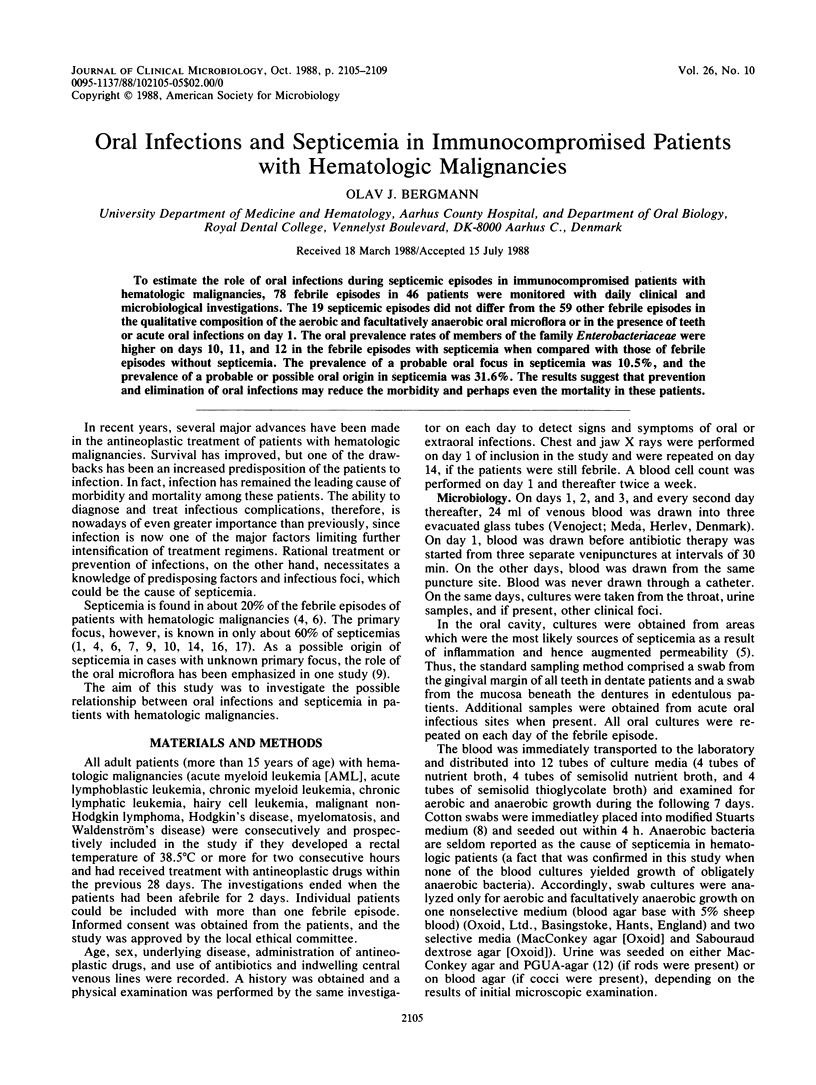
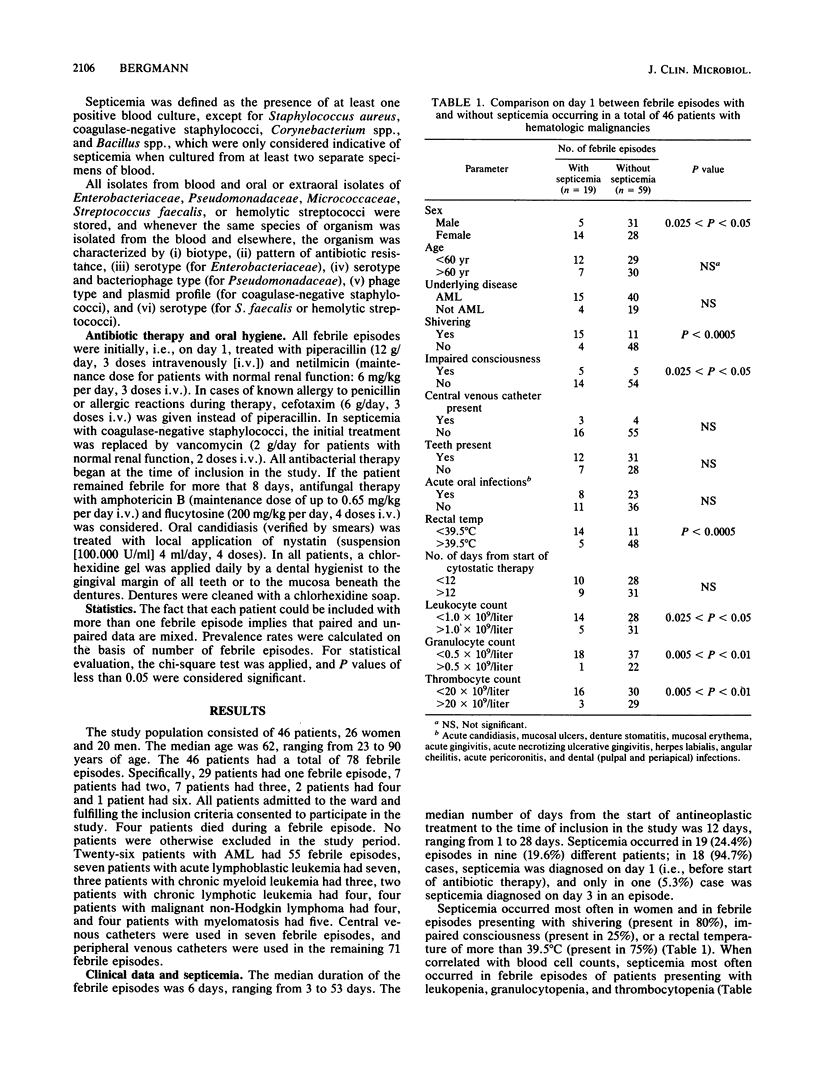
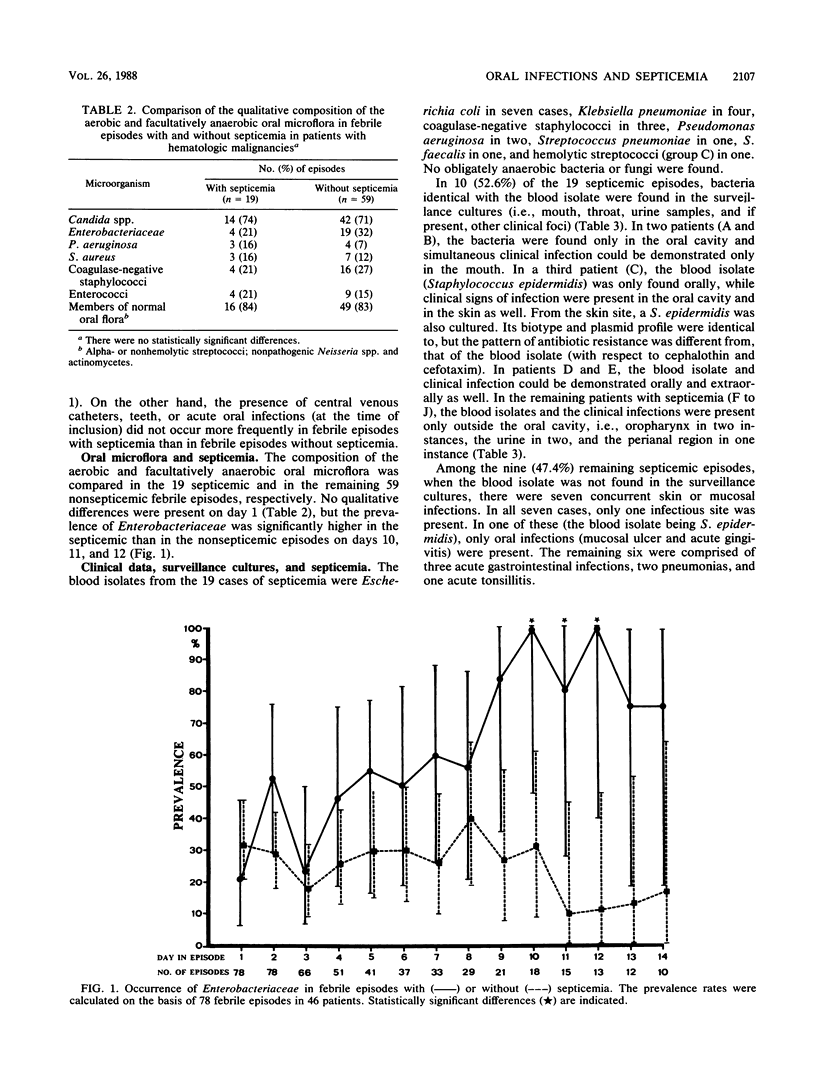
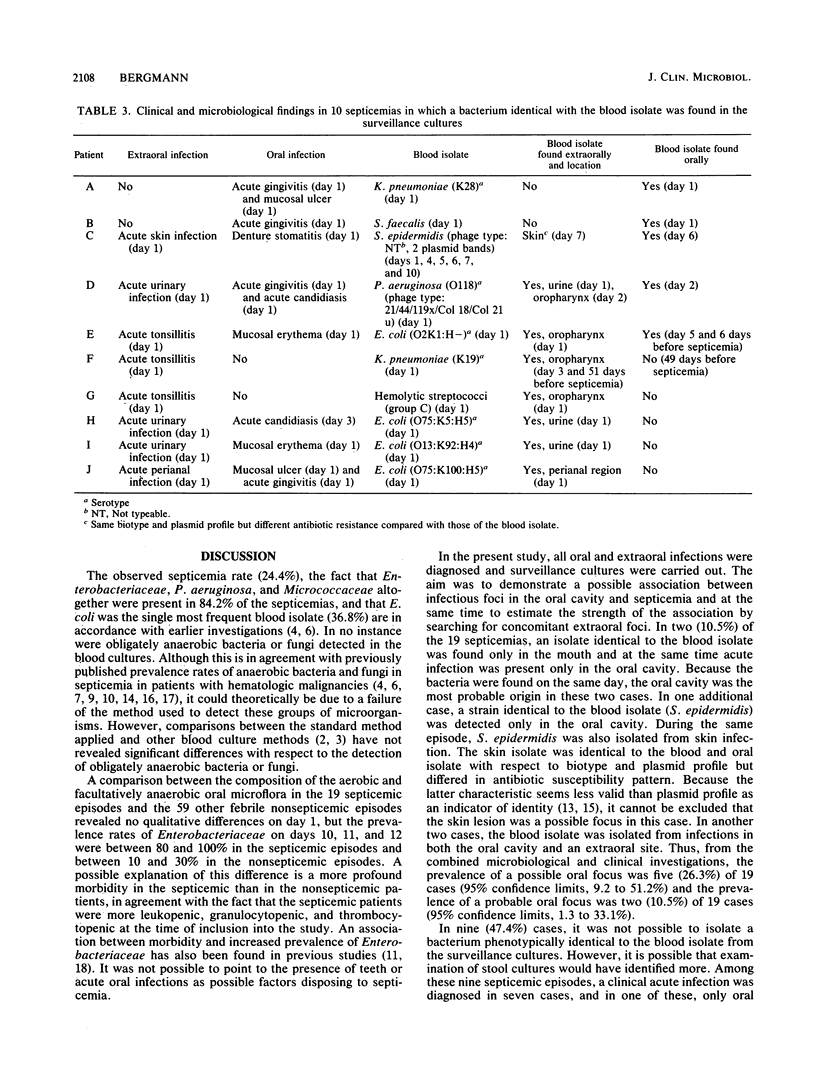
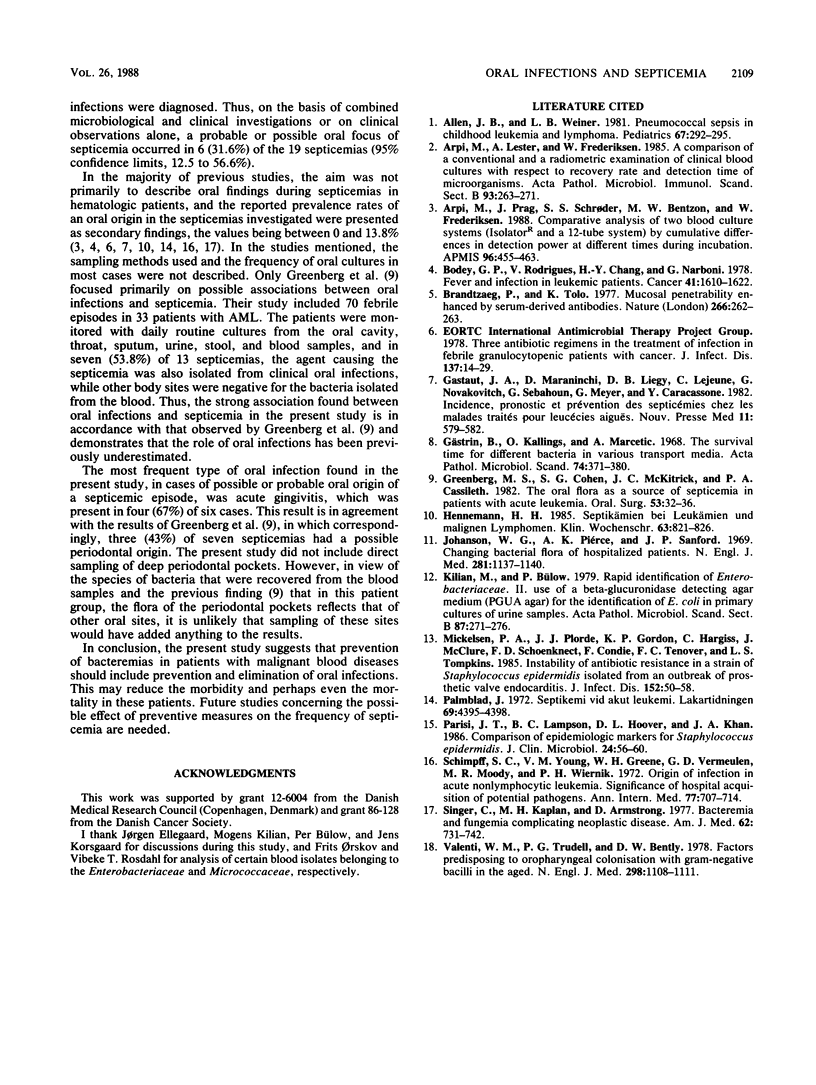
Selected References
These references are in PubMed. This may not be the complete list of references from this article.
- Allen J. B., Weiner L. B. Pneumococcal sepsis in childhood leukemia and lymphoma. Pediatrics. 1981 Feb;67(2):292–295. [PubMed] [Google Scholar]
- Arpi M., Lester A., Frederiksen W. A comparison of a conventional and a radio-metric examination of clinical blood cultures with respect to recovery rate and detection time of microorganisms. Acta Pathol Microbiol Immunol Scand B. 1985 Aug;93(4):263–271. doi: 10.1111/j.1699-0463.1985.tb02887.x. [DOI] [PubMed] [Google Scholar]
- Arpi M., Prag J., Schrøder S. S., Bentzon M. W., Frederiksen W. Comparative analysis of two blood culture systems (Isolator and a 12-tube system) by cumulative differences in detection power at different times during incubation. APMIS. 1988 May;96(5):455–463. doi: 10.1111/j.1699-0463.1988.tb05329.x. [DOI] [PubMed] [Google Scholar]
- Bodey G. P., Rodriguez V., Chang H. Y., Narboni Fever and infection in leukemic patients: a study of 494 consecutive patients. Cancer. 1978 Apr;41(4):1610–1622. doi: 10.1002/1097-0142(197804)41:4<1610::aid-cncr2820410452>3.0.co;2-b. [DOI] [PubMed] [Google Scholar]
- Brandtzaeg P., Tolo K. Mucosal penetrability enhanced by serum-derived antibodies. Nature. 1977 Mar 17;266(5599):262–263. doi: 10.1038/266262a0. [DOI] [PubMed] [Google Scholar]
- Gastaut J. A., Maraninchi D., Bagarry Liegey D., Lejeune C., Novakovitch G., Sebahoun G., Meyer G., Carcassonne Y. Incidence, pronostic et prévention des septicémies chez les malades traités pour leucémies aiguës. Nouv Presse Med. 1982 Feb 20;11(8):579–582. [PubMed] [Google Scholar]
- Greenberg M. S., Cohen S. G., McKitrick J. C., Cassileth P. A. The oral flor as a source of septicemia in patients with acute leukemia. Oral Surg Oral Med Oral Pathol. 1982 Jan;53(1):32–36. doi: 10.1016/0030-4220(82)90483-2. [DOI] [PubMed] [Google Scholar]
- Gästrin B., Kallings L. O., Marcetic A. The survival time for different bacteria in various transport media. Acta Pathol Microbiol Scand. 1968;74(3):371–380. doi: 10.1111/j.1699-0463.1968.tb03490.x. [DOI] [PubMed] [Google Scholar]
- Hennemann H. H. Septikämien bei Leukämien und malignen Lymphomen. Häufigkeit--Erreger--Ursachen. Klin Wochenschr. 1985 Sep 2;63(17):821–826. doi: 10.1007/BF01732287. [DOI] [PubMed] [Google Scholar]
- Johanson W. G., Pierce A. K., Sanford J. P. Changing pharyngeal bacterial flora of hospitalized patients. Emergence of gram-negative bacilli. N Engl J Med. 1969 Nov 20;281(21):1137–1140. doi: 10.1056/NEJM196911202812101. [DOI] [PubMed] [Google Scholar]
- Kilian M., Bülow P. Rapid identification of Enterobacteriaceae. II. Use of a beta-glucuronidase detecting agar medium (PGUA agar) for the identification of E. coli in primary cultures of urine samples. Acta Pathol Microbiol Scand B. 1979 Oct;87(5):271–276. [PubMed] [Google Scholar]
- Mickelsen P. A., Plorde J. J., Gordon K. P., Hargiss C., McClure J., Schoenknecht F. D., Condie F., Tenover F. C., Tompkins L. S. Instability of antibiotic resistance in a strain of Staphylococcus epidermidis isolated from an outbreak of prosthetic valve endocarditis. J Infect Dis. 1985 Jul;152(1):50–58. doi: 10.1093/infdis/152.1.50. [DOI] [PubMed] [Google Scholar]
- Palmblad J. Septikemi vid akut leukemi. Lakartidningen. 1972 Sep 20;69(39):4395–4398. [PubMed] [Google Scholar]
- Parisi J. T., Lampson B. C., Hoover D. L., Khan J. A. Comparison of epidemiologic markers for Staphylococcus epidermidis. J Clin Microbiol. 1986 Jul;24(1):56–60. doi: 10.1128/jcm.24.1.56-60.1986. [DOI] [PMC free article] [PubMed] [Google Scholar]
- Schimpff S. C., Young V. M., Greene W. H., Vermeulen G. D., Moody M. R., Wiernik P. H. Origin of infection in acute nonlymphocytic leukemia. Significance of hospital acquisition of potential pathogens. Ann Intern Med. 1972 Nov;77(5):707–714. doi: 10.7326/0003-4819-77-5-707. [DOI] [PubMed] [Google Scholar]
- Singer C., Kaplan M. H., Armstrong D. Bacteremia and fungemia complicating neoplastic disease. A study of 364 cases. Am J Med. 1977 May;62(5):731–742. doi: 10.1016/0002-9343(77)90876-2. [DOI] [PubMed] [Google Scholar]
- Valenti W. M., Trudell R. G., Bentley D. W. Factors predisposing to oropharyngeal colonization with gram-negative bacilli in the aged. N Engl J Med. 1978 May 18;298(20):1108–1111. doi: 10.1056/NEJM197805182982002. [DOI] [PubMed] [Google Scholar]


